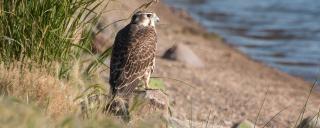
Prairie Falcon
| Scientific Name | Falco mexicanus |
|---|---|
| General Description | L 16”, WS 40”, 1.6lb. Brown overall, sports a thin “mustache” and a white breast speckled with brown spots. |
| Status | Year-round, some migratory. Peak breeding season April to July. |
| Abundance | Uncommon. |
| Primary Habitat | Expanses of native prairie, the badlands, and high cliffs along stream valleys or isolate buttes. |
| Federal Status | Migratory Bird. |
| Reason for Designation | The status of Prairie Falcons in North Dakota is unclear. It is on the USFWS Bird of Conservation Concern list in Region 6 and BCR 17. Partners in Flight (PIF) identifies the Prairie Falcon as a Regional Concern Species. |
Locations and Conditions of Key Habitat
Preferred Habitat
Shortgrass prairie, shrubsteppe, and agricultural habitats in generally arid landscapes. Nest primarily on cliffs, buttes, canyon walls, rock outcrops, and ridges. Aeries include depressions into the side of a cliff, horizontal ledges, or may use artificial cliff cavities created by humans. Aerie usually located in the top two-thirds of the cliff. Prairie Falcons may, although rarely, also nest in trees, transmission line towers, or in abandoned nests of other birds. Nest sites tend to face south. Home ranges average around 70 km². Primary prey items include ground squirrels, passerines (particularly horned larks), lizards, and other small rodents.
Key Areas and Conditions for Prairie Falcon in North Dakota
No specific sites have been identified. However, many current and former aeries are known.
Problems Which May Affect this Species
Habitat
Destruction or degradation of native prairie resulting in the loss of foraging habitat or prey species may impact populations. Grazing does not appear to affect falcons.
Other Natural or Manmade Factors
Illegal shooting may be a cause of mortality. Prairie Falcons were sensitive to pesticides such as DDT which resulted in lost productivity. Oil and gas development does not appear to significantly impact breeding falcons, but too much blasting close to the nest may have minor ramifications. Human disturbance may be a potential factor resulting in nest failure. Nests closer to roads and easily accessed or disturbed by human activities have resulted in less success. Mortality from collisions with fences occurs.
Research and Survey Efforts
Current Research or Surveys
- Nothing specific to the species in North Dakota.
Previous Research or Surveys
- A survey of Prairie Falcons in parts of southwest North Dakota in 1976 and 1977 resulted in 27 active aeries (Postovit 1979).
- In the mid 1980s, Prairie Falcons were resurveyed in the southwest and a population estimate of 107±77 birds was determined (Allen 1985).
- Prairie Falcon aeries within the administrative boundaries of the Little Missouri National Grasslands were surveyed in 2002. At least 7 of 88 surveyed nest sites were found to be active (Knowles 2002).
Additional Research or Surveys Needed
- Survey historic or potential nesting sites. Resurvey all known aeries and conduct a comprehensive review of the previous survey and research efforts in the southwest. Prairie Falcons have been surveyed several times in the past 25 years but the study areas, timing, and methods have varied greatly. A comprehensive and precise survey should be conducted for the entire southwest to determine the actual distribution and abundance of Prairie Falcons.
- Explore the effects of management practices on Prairie Falcons and associated prey species.
Population and Trend Estimates
- PIF Global Population Estimate: 80,000
- PIF North American Population Estimate: 70,000
- PIF North Dakota Population Estimate: 700
Management Recommendations
- Ensure new power lines are constructed to specifications that prevent raptor electrocutions.
- Maintain grasslands complexes including CRP.
- Preserve ground squirrel colonies and habitats near falcon nest sites.
- Maintain buffer zones around aeries.
- Mining operations should not be conducted within 0.8-1.6 km of nest sites, blasting should not occur within 125 m, and no more than three blasts per day.
- Artificial aeries may be created on southwest-facing slopes of non-eroding rock, at least 14m tall, about two-thirds the height of the nest cliff, and floor should be about 7,000 cm².
Monitoring Plans
According to the Partners in Flight Landbird Conservation Plan, long-term population trend monitoring such as the Breeding Bird Survey produces imprecise trends for this species. Continue to maintain a list of known Prairie Falcon nest sites. Monitoring plans should follow recommendations of the North American Bird Conservation Initiative ‘Opportunities for Improving Avian Monitoring’.
2005-2015 Progress
The Prairie Falcon remains a Level I Species of Conservation Priority. A nest site spatial database has been developed and is being used to minimize impacts to nesting falcons.

Note: A listing of works consulted when compiling the information on this page may be found in the 2015 State Wildlife Action Plan.
